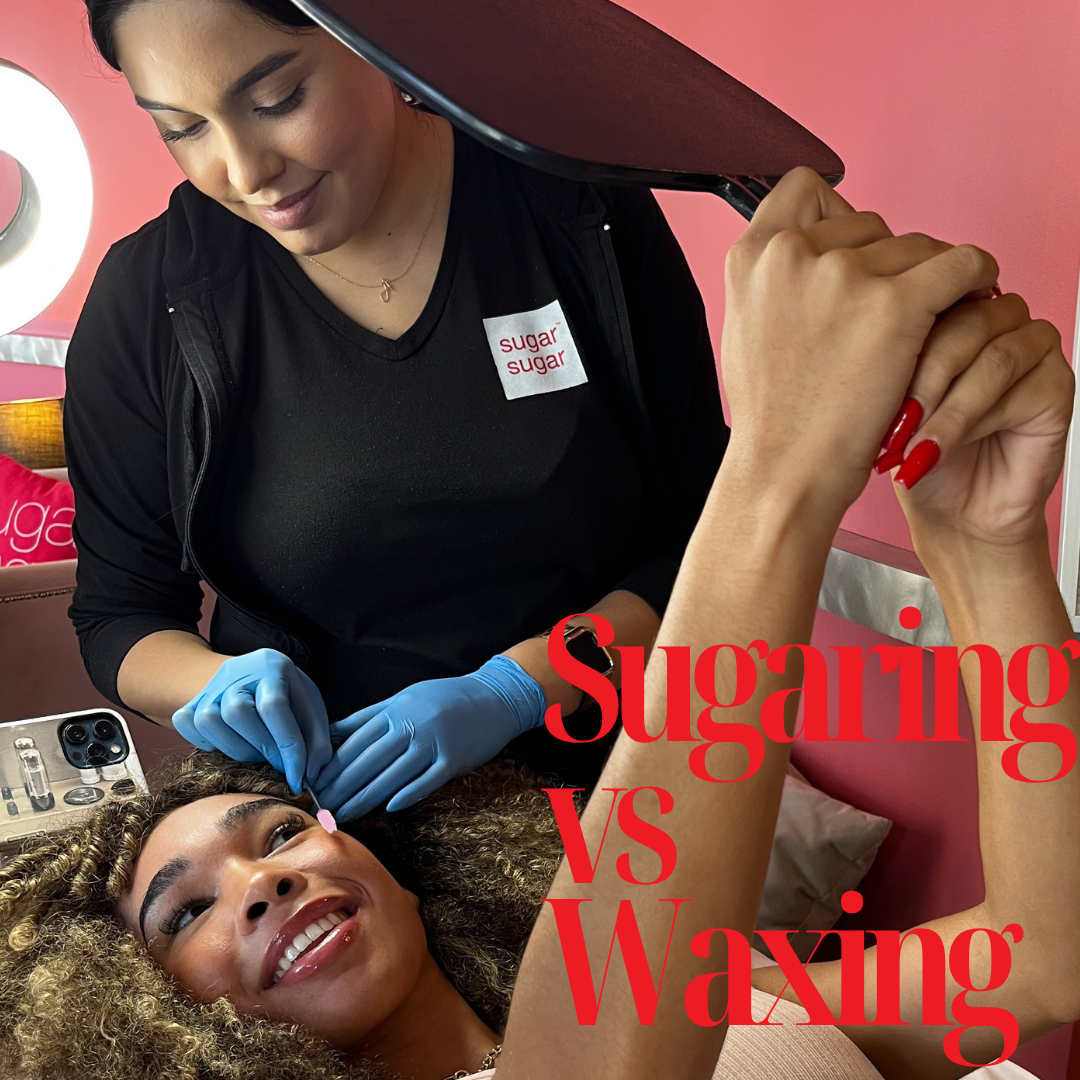Sugar ~ Spray ~ Skin ~ Brow Science™
Sugar Sugar™ Blog
#sugarsugar
August 21, 2025
Sugaring vs. Waxing: The Skin-Friendly Hair Removal Revolution

Do you struggle with red, bumpy irritated skin after waxing? You're not alone. Many are discovering the benefits of sugaring over traditional waxing, a shift in the beauty industry that promises less irritation and more comfort. Unlike waxing, sugaring gently exfoliates without the heat, grabbing the hairs deeper into the root for better progress. As more people seek out clean beauty solutions, Here at Sugar Sugar™, our technique of Comfort Sugaring™ stands out as a science-backed, non-toxic alternative that promises long-term care and visible results. Join us as we explore why sugaring might just be your skin's new best friend in the quest for smooth, healthy skin. Learn more.
Comfort Sugaring™: The Gentle Alternative
At Sugar Sugar™, all of our estheticians get extensive training through SSU- Sugar Sugar™ University- to ensure they perfect the technique of comfort sugaring™. It is a less painful alternative, where the esthetician works in small sections but still moving quickly. Following the direction of the hair growth, rather than against, minmizing the chances of getting grown hairs.
How Sugaring Works
Sugaring relies on a paste made from natural ingredients like sugar, lemon, and water. This mixture is applied at room temperature, which means there's no risk of burns.
The sugaring paste is gently molded onto the skin.
The esthetician flicks the paste off, pulling hair in the natural direction of growth.
This method reduces hair breakage and minimizes discomfort.
Sugaring adheres only to dead skin cells and hair, not live skin, making it less likely to cause irritation. This process leaves skin feeling smooth and refreshed.
Benefits for Sensitive Skin
For those with sensitive skin, sugaring is a game-changer. The all-natural ingredients mean fewer chemicals, reducing the likelihood of allergic reactions.
Non-irritating: By avoiding harsh chemicals, sugaring minimizes redness and irritation.
Reduced discomfort: The technique of pulling hair in the natural direction diminishes the risk of ingrown hairs, and make it more comfortable.
Sugaring is perfect for those prone to allergic reactions or skin conditions like eczema.
Gentle Exfoliation Features
Sugaring doesn't just remove hair; it also offers a mild exfoliation. This dual action is beneficial for overall skin health.
Exfoliates naturally: Sugaring removes dead skin cells, revealing fresher skin underneath.
Improves texture: Regular sugaring sessions can lead to smoother, softer skin over time.
Prevents buildup: By clearing away dead skin, sugaring helps prevent clogged pores and ingrown hairs.
This gentle exfoliation makes sugaring ideal for those looking to enhance their skin care routine.
Waxing: Traditional Method Explained
Waxing has long been the go-to method for hair removal, but it's not without its drawbacks. Understanding the process can help you make informed decisions about your skin care.
Process and Ingredients
Waxing involves applying a warm wax to the skin and removing it quickly to pull out hair. This method can be effective but may also cause discomfort.
Ingredients: Many waxes contain resins, preservatives, and other synthetic ingredients.
Application: Wax is typically heated and applied in strips, then quickly removed.
Pain factor: The pulling action can be painful, especially for those with sensitive skin.
The ingredients in wax can sometimes irritate the skin, leading to redness and bumps.
Impact on Skin Health
While waxing is effective, it can impact skin health, especially for sensitive skin types.
Irritation risk: The heat and synthetic ingredients can cause skin irritation.
Potential burns: Hot wax can lead to burns if not properly managed.
Skin trauma: The pulling action may cause micro-tears in the skin.
For those with sensitive skin, these factors can lead to longer recovery times and increased discomfort.
Addressing Ingrown Hairs
Ingrown hairs are a common issue with waxing, as the method can cause hair to break below the surface.
Prevention tips: Exfoliating before waxing can help prevent ingrown hairs.
Aftercare: Moisturizing and using exfoliating scrubs post-waxing can reduce ingrown hair risks.
Treatment: Ingrown hairs can sometimes require additional treatment, like topical solutions or visits to a skincare professional.
Addressing these concerns is crucial for maintaining healthy skin after waxing.
Which is Right for You?
Deciding between sugaring and waxing depends on your skin type and personal preferences. Both methods have their pros and cons.
Comparing Effects on Skin
Here's a comparison of how each method affects the skin:
Feature
Sugaring
Waxing
Skin Irritation
Minimal
Higher
Exfoliation
Gentle
Minimal
Ingrown Hair Risk
Lower
Higher
Pain Level
Lower
Higher
Sugaring is generally better for sensitive skin, while waxing may be more suitable for those looking for a quick solution.
Making the Smart Choice
Choosing between sugaring and waxing involves considering several factors:
Skin type: Sensitive skin typically fares better with sugaring.
Pain tolerance: If you're pain-sensitive, sugaring might be more comfortable.
Frequency: Sugaring often leads to slower hair regrowth, reducing the need for frequent sessions.
Expert Tips for Skin Care
Here are some expert tips to maintain healthy skin post-treatment:
Moisturize regularly to keep skin hydrated.
Exfoliate gently between sessions to prevent ingrown hairs.
Avoid sun exposure immediately after hair removal to prevent irritation.
Following these tips can help ensure your skin remains smooth and healthy, no matter what you pick!
